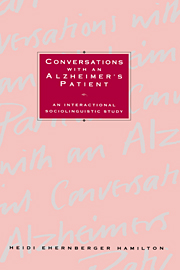2 - Communicative profile of Elsie
Published online by Cambridge University Press: 27 March 2010
Summary
In chapter 1 we saw that language problems of Alzheimer's disease patients seem to be not on the syntactic level, but on the discourse level. This chapter is meant to give the reader a general sense for the discourselevel abilities and difficulties of the Alzheimer's patient whose conversations are at the heart of this study. This communicative profile of Elsie should serve to contextualize the more specific analyses of questions and responses as presented in chapters 3 and 4.
This chapter begins with a discussion of the notions of taking the role of the other and automaticity of language. These notions then help us to understand Elsie's observed communicative abilities and difficulties as parts of a coherent whole rather than as unrelated occurrences. Against this comprehensive background, communicative phenomena which are problematic to the interactions are outlined, illustrated by typical examples from the fourteen conversations between November 1981 and March 1986.
To aid the reader who would like to relate specific examples to the larger interaction, reference is made following each example first to the number (in parentheses) which signifies the conversation's placement within the listing in chapter 1 followed by the date the conversation took place.
Taking the role of the other
Critical to an individual's success as a conversational partner is the ability to take the role of the other at every point in each given conversation. It is only by figuratively stepping into the mind of the addressee of our remarks that we are able to accomplish conversational coherence and maintain mutual face in interaction at the same time.
- Type
- Chapter
- Information
- Conversations with an Alzheimer's PatientAn Interactional Sociolinguistic Study, pp. 37 - 77Publisher: Cambridge University PressPrint publication year: 1994



